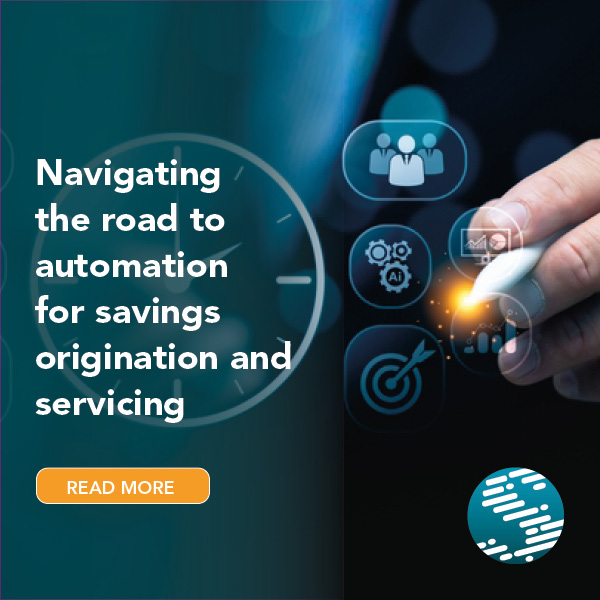
Navigating the road to automation for savings origination and servicing
The UK savings sector stands at the cusp of a transformative opportunity, particularly in the realm of automating digital origination. Through various recent discussions with our customers, partners, and other members of Financial Institutions (FIs), it has become evident that mid-tier and smaller FIs are not yet fully leveraging the potential to enhance efficiency and automate savings account origination processes.
While navigating innovation within constraints can be a formidable challenge – be it limited budgets, resource scarcity, or entrenched legacy systems, the strategic adoption of automation can be a compelling pathway to overcoming these challenges. Despite the relentless pressure to keep pace with fierce market competition, automation has the power to redefine the game, delivering tangible improvements that resonate across operations.
Sandstone Technology found in a recent market scan of UK FIs that on average more than 75%* of FIs don’t have digital origination capabilities. They are lagging, relying on outdated manual processes. Many FIs still grapple with challenges such as technological debt and substandard customer experiences, with paper-based applications and lengthy onboarding times remaining all too common. These issues can often stem from a reluctance or inability to adopt automation.
Why the hesitation to automate? Revenue pressures, cost constraints and margin compression all heavily influence how much UK FIs are willing to invest. The journey to full automation is fraught with challenges that demand careful navigation. Aiming for complete automation from day one often leads to long implementation timelines and delayed benefits. Mistakes in vendor selection, scope definition, or alignment with staff experience can prove costly, and the expense of building, implementing, and maintaining a fully automated system is substantial. Ongoing updates, driven by changes in integrations, regulations, and technologies, add further complexity.
Moreover, perfection is rarely achieved on the first attempt. Transitioning from no technology to semi-automation offers a more manageable alternative, delivering immediate benefits ranging from improved customer satisfaction to reduced operational expenses. Structured information capture during this phase enhances staff experience by lowering rework, decision-making overheads, and customer friction, creating a solid foundation for further automation advancements.
Overcoming skills and budget challenges
New entrant banks, specialist lenders, private banks and progressive building societies often have finite budgets and smaller teams compared to their top-tier competitors, as we’ve learned from speaking with members of the UK’s Association of Savings Professionals.
Executives are concerned about the skills gaps in their businesses, and how they affect their capacity and capability to implement automation. There is an ongoing issue around the cost of acquiring new technology; and the idea of engaging an extensive resource for an extended period is a pipe dream for many.
Even if an FI does decide to hire the skilled contractors required to deliver an automation program, it’s not a simple matter of disbanding the team once the project is delivered. There will always be a need for ongoing upkeep, for regular vulnerability fixes and maintenance – no digital banking solution is static.
Increasing numbers of FIs are relying on the expertise of their technology partners to help deliver critical improvements. Based on our observations and expertise, we believe most FIs also need a consistent support team that can maintain their digital platform for the long term. Consequently, their technology partners are often instrumental in enabling them to adapt as needed, upgrading and testing systems after implementation and ensuring compliance with ever-evolving regulatory requirements.
Easing the core banking blockage with digital origination
One of the biggest bottlenecks delaying automation innovation is the technical debt some FIs hold in their existing infrastructure. It can be difficult to change their core banking platforms to offer the desired functionality or handle the required integration. To enhance the core banking platform would be a huge project in itself.
But there may still be ways forward. A good starting point for an FI is to identify its greatest need. Given there are still many institutions in the UK doing mail-in, paper-based savings applications which can take, at best, a week to onboard customers, the FI’s most significant challenge may lie in delivering a consistently positive customer experience.
Research shows that on average, more than 95% of FIs don’t have specialised lead gen forms across their product offerings. Some FIs still offer a downloadable PDF form or, at best, basic application capture systems, leaving the burden of processing to bank staff. This approach not only slows down operations but detracts from the overall customer experience, highlighting the need for more efficient automated solutions.
Based on that priority, the FI’s next step might be to adopt automated origination solutions that can perform the IDV checks and any other verifications required to ensure it’s an authentic application. A digital origination process substantially reduces time to onboard and can be made available to the customer 24/7 allowing instant funding of accounts through mobile banking and online banking. In this scenario, onboarding becomes almost instant, and the customer can immediately log on and transact on the opened account.
Automation alleviates the burden of manual tasks for financial institutions (FI’s), such as re-keying data into relevant systems and generating paperwork to respond to customers and set up accounts. Without automation, scaling the onboarding process to handle increased daily application volumes would require a substantial increase in full-time employees (FTEs). The benefits of automation, both in cost and labor savings, are evident.
Fast funding of lending arms
Another casualty of an FI’s failure to automate can be their ability to raise funding efficiently.
The savings market is a competitive sector. FI’s compete with one another offering better savings interest rates to attract both new and existing customers to raise funds and hit a pre-set tranche level. If the FI needs to bring in £10m as an example, and the application process is not automated, onboarding new savings customers and receiving funds can take weeks. The FI may have to wait a long time to reach that target tranche, even if they’re well placed in a Best Buy table.
Compare that to an FI that has an automated journey, taking minutes to complete and fund their account – they could reach the desired tranche level in a much shorter period. More money comes into the FI faster, reducing the funding cycle.
Faster benefits through phased automation
In many cases, taking small but measured steps toward full automation makes more sense than mounting a large program of work, as does building a tighter, more agile team to manage changes quickly and continuously for a shorter period.
That change process might start with a three- or six-month engagement to automate an initial area of operations. After the first phase has been delivered, the client has an opportunity to test and verify that product. After the solution goes live, those fast benefits are won and the program moves onto the next phase, which reaps yet more benefits, and so on. These milestones enable the FI to gain immediate traction and start to relieve their cost pressures and margin compression sooner.
While a large program has the potential to achieve full automation on completion, it may take longer to implement and realise its benefits. Another risk is that an FI takes on a large program of work spanning several years, only for the market to shift direction during that time. Pivoting mid project becomes an exceedingly costly undertaking, or even worse, the FI may deliver a program which is no longer relevant to the market.
It’s not all or nothing
Implementing automation in bite-sized chunks, in our experience, reduces your cost to serve, satisfies more customers and motivates staff as there are fewer mundane tasks on their to-do lists.
Based on discussions with savings sector executives, this approach aligns with FI’s current thinking. But the most reassuring feedback is that the products and solutions Sandstone Technology has in the market right now, and those on our horizon of delivery, are keeping pace with the market – if not out-running it.
Download the brochure or contact the Sandstone Technology team now to arrange a personalised automation strategy session for your digital banking and digital origination needs.
*Based on market scan of 154 UK FIs conducted by Sandstone Technology.


